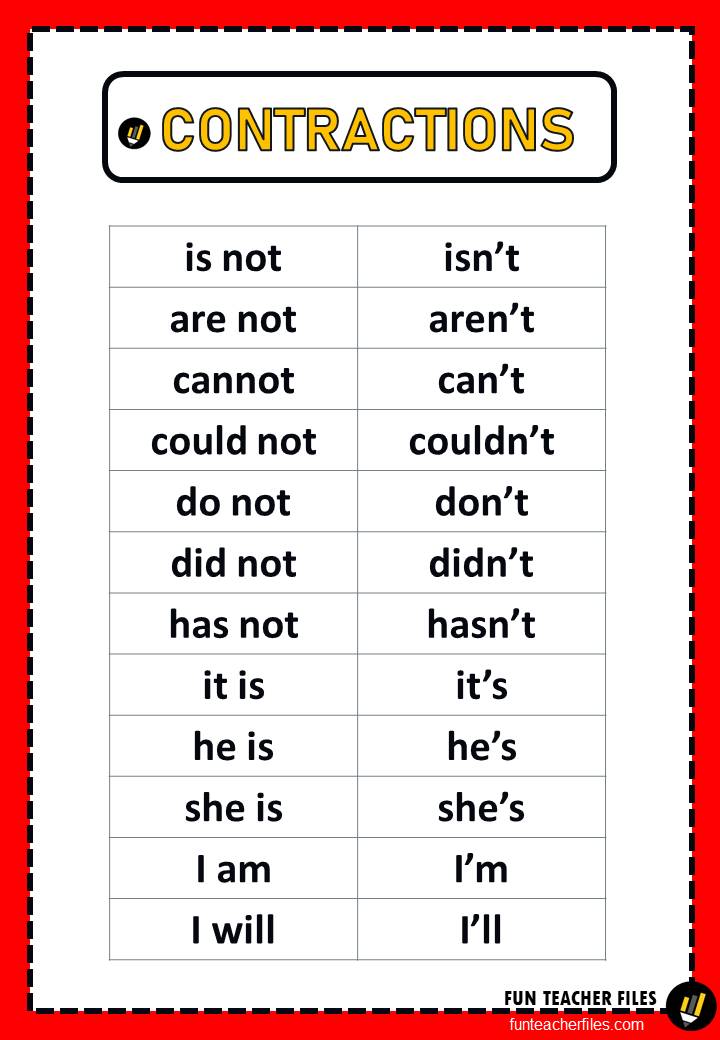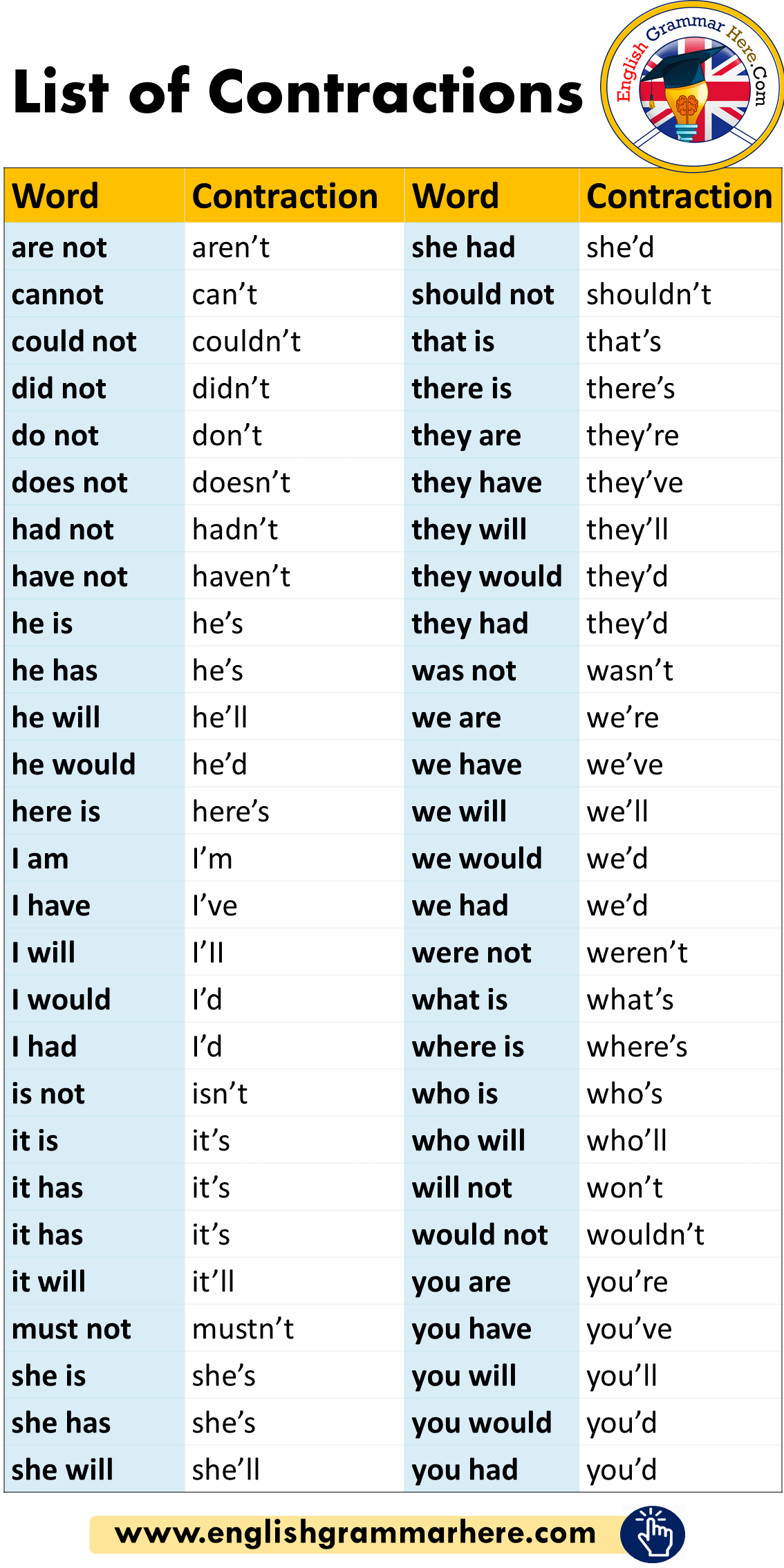Would Not Contracted Form
Would Not Contracted Form - Most contractions in english are pretty straightforward: We use contractions (i’m, we’re) in everyday speech and informal writing. We seldom use short/contracted forms after names and nouns. He would is shortened to he’d; The short/contracted forms 's and 'd have have two different long forms: Contractions, which are sometimes called ‘short forms’, commonly.
He would is shortened to he’d; Contractions, which are sometimes called ‘short forms’, commonly. We use contractions (i’m, we’re) in everyday speech and informal writing. The short/contracted forms 's and 'd have have two different long forms: We seldom use short/contracted forms after names and nouns. Most contractions in english are pretty straightforward:
We use contractions (i’m, we’re) in everyday speech and informal writing. We seldom use short/contracted forms after names and nouns. Most contractions in english are pretty straightforward: The short/contracted forms 's and 'd have have two different long forms: Contractions, which are sometimes called ‘short forms’, commonly. He would is shortened to he’d;
Contractions Chart in English Grammar Fun Teacher Files
We seldom use short/contracted forms after names and nouns. We use contractions (i’m, we’re) in everyday speech and informal writing. Most contractions in english are pretty straightforward: Contractions, which are sometimes called ‘short forms’, commonly. He would is shortened to he’d;
Contracted negative forms of auxiliary verbs Contractions in English
Contractions, which are sometimes called ‘short forms’, commonly. The short/contracted forms 's and 'd have have two different long forms: He would is shortened to he’d; Most contractions in english are pretty straightforward: We seldom use short/contracted forms after names and nouns.
+150 Contracted Forms of Verbs (Simple Guide) TPR Teaching
We use contractions (i’m, we’re) in everyday speech and informal writing. The short/contracted forms 's and 'd have have two different long forms: We seldom use short/contracted forms after names and nouns. Contractions, which are sometimes called ‘short forms’, commonly. Most contractions in english are pretty straightforward:
List of Contractions Contraction Words Used in Writing and Speaking
We use contractions (i’m, we’re) in everyday speech and informal writing. The short/contracted forms 's and 'd have have two different long forms: We seldom use short/contracted forms after names and nouns. Contractions, which are sometimes called ‘short forms’, commonly. He would is shortened to he’d;
Detailed Contractions List in English English Grammar Here English
Contractions, which are sometimes called ‘short forms’, commonly. The short/contracted forms 's and 'd have have two different long forms: Most contractions in english are pretty straightforward: He would is shortened to he’d; We seldom use short/contracted forms after names and nouns.
It’s Okay to Use Contractions ENG4U Kevin Streight
He would is shortened to he’d; Most contractions in english are pretty straightforward: Contractions, which are sometimes called ‘short forms’, commonly. The short/contracted forms 's and 'd have have two different long forms: We seldom use short/contracted forms after names and nouns.
Contractions 70+ Contractions in English Contraction Words
He would is shortened to he’d; We use contractions (i’m, we’re) in everyday speech and informal writing. Most contractions in english are pretty straightforward: We seldom use short/contracted forms after names and nouns. The short/contracted forms 's and 'd have have two different long forms:
List of Contractions in English English Study Page
We seldom use short/contracted forms after names and nouns. He would is shortened to he’d; Most contractions in english are pretty straightforward: We use contractions (i’m, we’re) in everyday speech and informal writing. The short/contracted forms 's and 'd have have two different long forms:
+150 Contracted Forms of Verbs (Simple Guide) TPR Teaching
He would is shortened to he’d; Most contractions in english are pretty straightforward: We use contractions (i’m, we’re) in everyday speech and informal writing. The short/contracted forms 's and 'd have have two different long forms: Contractions, which are sometimes called ‘short forms’, commonly.
Pin on Contractions
Most contractions in english are pretty straightforward: He would is shortened to he’d; We use contractions (i’m, we’re) in everyday speech and informal writing. Contractions, which are sometimes called ‘short forms’, commonly. The short/contracted forms 's and 'd have have two different long forms:
We Use Contractions (I’m, We’re) In Everyday Speech And Informal Writing.
He would is shortened to he’d; We seldom use short/contracted forms after names and nouns. Most contractions in english are pretty straightforward: The short/contracted forms 's and 'd have have two different long forms:









